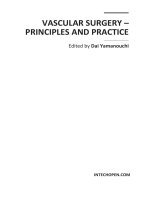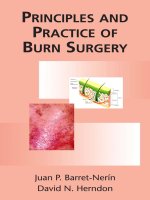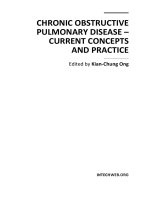Vascular Surgery – Principles and Practice Edited by Dai Yamanouchi potx
Bạn đang xem bản rút gọn của tài liệu. Xem và tải ngay bản đầy đủ của tài liệu tại đây (5.82 MB, 108 trang )
VASCULAR SURGERY –
PRINCIPLES AND PRACTICE
Edited by Dai Yamanouchi
Vascular Surgery – Principles and Practice
Edited by Dai Yamanouchi
Contributors
Luigi Chiariello, Paolo Nardi, Francesco Versaci, Igor Koncar, Nikola Ilic, Marko Dragas,
Igor Banzic, Miroslav Markovic, Dusan Kostic, Lazar Davidovic, Kiriakos Ktenidis, Argyrios
Giannopoulos, H.J.P. Fokkenrood, G.J. Lauret, M.R.M. Scheltinga, H.J.M. Hendriks, R.A. de Bie,
J.A.W. Teijink, Jesus Barandiaran, Thomas Hall, Naif El-Barghouti, Eugene Perry, Charles P.E.
Milne, Regent Lee, Ashok I. Handa
Published by InTech
Janeza Trdine 9, 51000 Rijeka, Croatia
Copyright © 2012 InTech
All chapters are Open Access distributed under the Creative Commons Attribution 3.0 license,
which allows users to download, copy and build upon published articles even for commercial
purposes, as long as the author and publisher are properly credited, which ensures maximum
dissemination and a wider impact of our publications. After this work has been published by
InTech, authors have the right to republish it, in whole or part, in any publication of which they
are the author, and to make other personal use of the work. Any republication, referencing or
personal use of the work must explicitly identify the original source.
Notice
Statements and opinions expressed in the chapters are these of the individual contributors and
not necessarily those of the editors or publisher. No responsibility is accepted for the accuracy
of information contained in the published chapters. The publisher assumes no responsibility for
any damage or injury to persons or property arising out of the use of any materials,
instructions, methods or ideas contained in the book.
Publishing Process Manager Vedran Greblo
Typesetting InTech Prepress, Novi Sad
Cover InTech Design Team
First published October, 2012
Printed in Croatia
A free online edition of this book is available at www.intechopen.com
Additional hard copies can be obtained from
Vascular Surgery – Principles and Practice, Edited by Dai Yamanouchi
p. cm.
ISBN 978-953-51-0828-3
Contents
Preface VII
Section 1 Carotid Surgery 1
Chapter 1 Simultaneous Hybrid Revascularization by Carotid Stenting
and Coronary Artery Bypass Grafting – The SHARP Study 3
Luigi Chiariello, Paolo Nardi and Francesco Versaci
Chapter 2 Carotid Graft Replacement
of the Stenotic Carotid Artery 11
Igor Koncar, Nikola Ilic, Marko Dragas, Igor Banzic,
Miroslav Markovic, Dusan Kostic and Lazar Davidovic
Section 2 Perioperative Care 29
Chapter 3 Current Management of Vascular Infections 31
Kiriakos Ktenidis and Argyrios Giannopoulos
Section 3 Peripheral Artery Disease and Varicose Vein 53
Chapter 4 The Role of Supervised Exercise Therapy
in Peripheral Arterial Obstructive Disease 55
H.J.P. Fokkenrood, G.J. Lauret, M.R.M. Scheltinga,
H.J.M. Hendriks, R.A. de Bie and J.A.W. Teijink
Chapter 5 Day Case Management of Varicose Veins 73
Jesus Barandiaran, Thomas Hall,
Naif El-Barghouti and Eugene Perry
Chapter 6 Iatrogenic Pseudoaneurysms 91
Charles P.E. Milne, Regent Lee and Ashok I. Handa
Preface
Vascular surgery is one of the specialties of surgery focusing on the vascular system of
the body, i.e. arteries and veins. The unique feature of this specialty is, unlike other
surgical specialty, that vascular surgeons routinely perform not only the conventional
open surgery but also the diagnostic and interventional endovascular procedures. For
that reason, the field of vascular surgery has evolved rapidly since the introduction of
the endovascular aneurysms repair (EVAR) as well as the numerous techniques and
devices of endovascular procedures for peripheral artery disease and varicose veins.
This book aims to provide a brief overview of conventional open vascular surgery,
endovascular surgery and pre- and post-operative management of vascular patients.
The collections of contributions from outstanding vascular surgeons and scientists
from around the world present detailed and precious information about the important
topics of the current vascular surgery practice and research. This book covers a wide
variety of issues and topics of the vascular surgery. I would like to acknowledge the
authors around the world for their excellent contributions to this book. I also would
like to express my special thanks to the managing editor of INTECH for providing me
numerous supports and advices.
I hope this book will be used worldwide by young vascular surgeons and medical
students enhancing their knowledge and stimulating the advancement of this field.
Dai Yamanouchi, MD, PhD
Assistant Professor of Vascular Surgery
University of Wisconsin School of Medicine and Public Health
USA
Section 1
Carotid Surgery
Chapter 1
© 2012 Chiariello et al., licensee InTech. This is an open access chapter distributed under the terms of the
Creative Commons Attribution License ( which permits
unrestricted use, distribution, and reproduction in any medium, provided the original work is properly cited.
Simultaneous Hybrid Revascularization by
Carotid Stenting and Coronary Artery
Bypass Grafting – The SHARP Study
Luigi Chiariello, Paolo Nardi and Francesco Versaci
Additional information is available at the end of the chapter
1. Introduction
Significant atherosclerotic disease affecting also the carotid artery system is encountered in a
substantial number of patients undergoing coronary artery bypass grafting (CABG) [1]. The
optimal surgical management to prevent stroke and cardiac events in this subset of patients
remains unclear [2-5]. Among patients undergoing carotid endoarterectomy (CEA)
procedure in the Veterans Affair Cooperative Study and in the Asymptomatic Carotid
Atherosclerosis Study, respectively 20% and 49% of deaths were related to cardiac causes
[4]. Similarly, the incidence of perioperative stroke in patients undergoing CABG is high in
those affected by concomitant significant carotid disease [2-4]. The combined surgical
approach is associated with an increased risk for mortality and morbidity [5]. In the staged
surgical approach which addresses the carotid artery lesion with carotid endoarterectomy
first, followed several days to several weeks by CABG, incidence of perioperative stroke
during CABG is reduced .However, the risk of myocardial infarction (MI) during the CEA
procedure and in the period preceding CABG remains high (6%) [6]. Carotid artery stenting
(CAS) using cerebral protection devices is rapidly evolving as an alternative to carotid
endoarterectomy [7], mainly for patients with severe carotid artery stenosis at high surgical
risk [8], such as patients with coronary artery disease. A staged CAS-CABG approach has
been recently proposed, but the need of a dual anti-platelet aggregation therapy lasting 3-4
weeks after stenting may represent a limitation for CABG [9].
2. Clinical experience
In our Institution in 2005 we introduced a new therapeutic strategy consisting of a
simultaneous hybrid revascularization by CAS, immediately followed by CABG and cases
Vascular Surgery – Principles and Practice
4
have been colleted in the SHARP study (“Simultaneous hybrid revascularization by carotid
artery stenting and coronary artery bypass grafting”) (Figure 1).
Figure 1.
As compared to the combined or staged surgical strategy currently adopted, the new hybrid
approach CAS-CABG can reduce the incidence of serious perioperative adverse events and
minimize surgical trauma. Surgical time and surgical trauma are shorter and less extensive
as compared to combined CEA and CABG. Risk of MI is expected to be reduced, by
shortening the interval between the two procedures [10, 11].
Eligible criteria for the enrolment: 1) concomitant critical carotid and coronary disease with
coronary arteries suitable for CABG; 2) EuroSCORE ≥5; 3) a carotid artery stenosis ≥50% in
the symptomatic disease or ≥80% in asymptomatic disease, as determined by the North
American Symptomatic Carotid Endarterectomy Trial (NASCET) criteria [2]. The presence
of carotid artery stenosis was evidenced by eco duplex scanning, then confirmed by catheter
angiography and either magnetic resonance angiography or computed tomography (CT)
scan angiography. A CT scan with or without angiographic dye, depending on
preprocedural serum levels of creatinine, was performed in all patients to provide the
maximum information regarding the aortic arch, the extent of aortic disease and the brain.
In case of bilateral carotid artery stenosis the choice of the carotid artery to treat was made
according to clinical criteria or to the severity and morphology of plaque in case of
asymptomatic patients. In a very few instances of bilateral subocclusive carotid stenosis,
successful bilateral CAS has been performed, immediately followed by CABG.
CAS procedures were performed under local anaesthesia through a percutaneous transfemoral
access with the use of stents and protection devices. An introducer sheath was positioned in the
Simultaneous Hybrid Revascularization by
Carotid Stenting and Coronary Artery Bypass Grafting – The SHARP Study
5
femoral artery, and heparin (1 mg /kg) was administered intra-arterially as a bolus. Then a
guiding catheter was placed in the common carotid artery, proximally to the bifurcation. A
distal filter protection was used in all patients. At the end of the procedure, patients were
transferred directly to the operating room; CABG procedure was performed by means of
normothermic cardiopulmonary bypass in the majority patients; in few cases off-pump CABG
procedure was performed according with the choice of surgeon and comorbidity of patient.
2.1. Periprocedural pharmacological protocol
Aspirin 100 mg daily was started at least 2 days before CAS and daily after combined
procedure was performed. Heparin was administered 1 mg /Kg as a bolus intra-arterially
immediately before the stent implantation procedure and in the operating room before the
cardiopulmonary bypass 2 mg/Kg as a bolus. Activated clotting time was checked every 30
minutes and was constantly maintained ≥ 250 sec. until the CABG procedure and ≥480
seconds until the end of the cardiopulmonary bypass. Tranexamic acid 2 g in bolus was
administered as an antifibrinolytic agent over 20 minutes before sternotomy and then as
endovenous infusion (0.5 g/h) until the patient was admitted to the postoperative intensive
care unit in most of cases. Clopidogrel, 300 mg as a loading dose, followed by 75 mg per day
for 1 month was started in the intensive care unit via a nasogastric tube 6 hours after the end
of CABG surgery, providing that surgical bleeding from the thoracic drains had either
stopped, or when it was less than 50 mL/hr for 3 consecutive hours from the sixth
postoperative hour on (Figure 2).
Figure 2.
Vascular Surgery – Principles and Practice
6
The primary end points analyzed were the incidence of stroke, MI or death at 30 days after
CAS-CABG and at a mid-term follow-up.
2.2. In-hospital and follow-up results
One-hundred and forty eight consecutive patients between January 2005 and November 2011
underwent CAS-CABG treatment. Mean age of patients was 68±8 years, means EuroSCORE
8.6±2.5; 22 patients (14.8%) were affected by symptomatic carotid disease; 67 (45%) had
bilateral carotid stenosis. Left internal mammary artery was used as graft to the left anterior
descending artery in all patients, bilateral mammary artery in 20 cases (13.5%). (Table 1).
Variable Value
Number of
p
atients 148
Age - years *
68±8
Male - n.
† (%)
118 (79)
CCS pre-op - mean *
2.7 ± 1
CCS class III/IV ‡ - n. (%)
93 (63)
Instable An
g
ina- n. (%) 34 (23)
NYHA – mean *
2.2 ± 1
Bilateral carotid stenosis- n. (%) 67 (45)
Previous Stroke o TIA - n. (%) 22 (14,8)
Surgical Risk**
8.6 ± 2.5
Doppler velocity of internal carotid artery. - mean *
325 ± 40 cm/sec
* ± DS
† n. = number
‡ Following classification of Canadian Cardiovascular Society (CCS).
§ Sierum creatinin concentration >1,5 mg/dl and clearence of creatinin <50 ml/min.
** Surgical Risk as EuroSCORE I (Eur J Cardiothor Surg 1999; 15:816-823).
MI= miocardial infarction; LVEF =Left ventrical ejection fraction.
Table 1. Preoperative details of patients.
Clinical major outcomes at 48 months are reported in Table 2
O
p
erative mortalit
y
1.3%
Periprocedural Stroke 1.3%
Perio
p
erative MI 0
Re-ex
p
loration for bleedin
g
2.0%
Stroke, MI or death within 48 months 6.1%
MI = myocardial infarction
Table 2. Incidence of Clinical Events up to 48 months
In the first one hundred patients we report a mean follow-up of 40±25 months, 97% complete.
In these patients we found at the end of follow-up 9 deaths whit a cumulative survival rate of
89%; furthermore we observed a very low mortality rate for cardiac late death (97±2%) and an
high rate of freedom from fatal stroke (we registered just one case of fatal stroke during follow-
up) (98±2%), MI (96±3%), and cerebrovascular events (90±6%). (Figure 3-6)
Simultaneous Hybrid Revascularization by
Carotid Stenting and Coronary Artery Bypass Grafting – The SHARP Study
7
Figure 3. Survival rate at follow-up
Figure 4. Kaplan Meier: Freedom from cardiac late death.
Figure 5. Kaplan Meier: Freedom from miocardial infarction.
Vascular Surgery – Principles and Practice
8
Figure 6. Kaplan Meier: freedom from fatal stroke.
Internal carotid artery systolic blood flow during follow-up, showed significant improvement
as compared to preoperative mean value. (67±10 cm/sec vs. 325±40 cm/sec, P < .001).
3. Comments
Neurological complications are relatively common after CABG, especially in high-risk
patients. Carotid artery disease is significantly associated with a type I adverse neurological
outcome (i.e., death due to stroke or hypoxic encephalopathy, nonfatal stroke, TIA, stupor,
or coma at the time of discharge). Significant carotid artery stenoses are associated with up
to 30% of early postoperative strokes following CABG. Preventing stroke and
cardiovascular events after CABG is an important and complex issue. Concomitant carotid
artery disease might be a major factor contributing to the occurrence of postoperative stroke.
Moreover, carotid artery disease might be a marker of diffuse atherosclerosis, affecting also
aortic arch, arch vessels, and intracranial vessels. In this high risk population, a simplified
operative management like hybrid revascularization by CAS and CABG can minimize the
negative impact of diffuse atherosclerotic disease. In fact, our findings indicate that, in
patients with combined carotid artery disease and coronary artery disease, the proposed
hybrid approach is a feasible therapeutic option with good immediate and short-term
clinical results. The recently reported incidence of perioperative stroke and mortality
following CEA and CABG is not negligible, ranging between 8.3% to 10.3% [12]. According
to these results, in a previous series of 100 consecutive patients undergoing combined
surgical revascularization at our Institution between 1991 and 2002, the 30-day mortality
and stroke rate was 10% and 1.1%, respectively, with a mortality rate of 14.5% when the
standard EuroSCORE was ≥ 6, and 3.4% when it was lower than 6. These high-risk patients
could be treated by an alternative strategy such as the hybrid approach proposed in this
study. As compared with combined surgical revascularization, the hybrid strategy requires
a shorter surgical time and less extensive surgical trauma, thus reducing cofactors known to
increase morbidity and mortality. In particular, in high-risk patients for CEA, mainly due to
severe CAD, the SAPPHIRE (Stenting and Angioplasty with Protection in Patients at High
Simultaneous Hybrid Revascularization by
Carotid Stenting and Coronary Artery Bypass Grafting – The SHARP Study
9
Risk for Endarterectomy) trial showed that CAS was safer than carotid endarterectomy,
because it had a lower postprocedural risk of myocardial infarction at 30 days as compared
with surgery. This is likely to be the case mainly in patients with elevated surgical risk, such
as the patients involved in the SHARP study. In particular, when the standard EuroSCORE
is 8, as it is in our study, the surgical mortality rate might be greater than 10-12%. In this
high-risk subset of patients, specific surgical complications are also increased up to 55% [13].
When both internal carotid arteries have significant stenosis, the risk of stroke after cardiac
surgery is particularly high (25%). With the percutaneous hybrid approach, in our study the
stroke rate was only 1.3%, considering that 45% of our patients had bilateral internal carotid
artery disease. Potential adjunctive advantage of the simultaneous hybrid approach as
compared with a combined surgical approach is that during the CAS procedure the patient
is awake and the neurological outcome will be known instantly rather than after the patient
emerges from general anaesthesia. Another most important finding of our study was the
absence of periprocedural rate of MI. By observing the proposed protocol, the risk of MI,
especially during carotid surgery or in the time elapsing between the two procedures (CEA
or CAS and CABG after 3-4 weeks from carotid procedure), is virtually eliminated. In the
two-stage procedure, the rate of MI when the patient is waiting for CABG after carotid
artery procedure is about 5-6%. Finally our study also demonstrated safety of the
pharmacological protocol and the timing of antiplatelet administration proposed: the
bleeding rate after surgical intervention was low.
The proposed hybrid approach conferred an operative mortality rate comparable to that of
isolated CABG.
In conclusions, the new hybrid approach is aiming to reduce risk of myocardial infarction,
of bleeding after CABG and risk of death and major cerebrovascular complications. Reduced
mortality and morbidity are expected to reduce also in-hospital stay and costs. Therefore, in
patients with combined carotid artery and coronary artery disease at higher surgical risk,
the proposed hybrid approach seems to be a possible, advantageous and safe alternative
therapeutic strategy.
At a mid-term period, a high rate of event-free survival and freedom from cerebrovascular
events can be expected.
Author details
Luigi Chiariello
*
, Paolo Nardi and Francesco Versaci
Cardiac Surgery Unit, Fondazione Policlinico Università Tor Vergata, Rome, Italy
4. References
[1] Alboyans V, Lacroix P. Indications for carotid screening in patients with carotid artery
disease. Presse Med 2009;38(6):977-86
*
Corresponding Author
Vascular Surgery – Principles and Practice
10
[2] Mackey WC, O’Donnell TF, Callow AD. Cardiac risk in patients undergoing carotid
endoarterectomy: impact on perioperative and long-term mortality. J Vasc Surg
1990;11:226-33.
[3] North American Symptomatic Carotid Endarterectomy Trial Collaborators. Beneficial
effect of carotid endoarterectomy in symptomatic patients with high-grade of carotid
stenosis. N Engl J Med 1991;325:445-53.
[4] European Carotid Surgery Trialist’ Collaborative Group. MRC European Carotid
Surgical Trial: interim results for symptomatic patients with severe (70-99%) or with
mild (0-29%) carotid stenosis. Lancet 1991;337:1235-43.
[5] Executive committee for the asymptomatic carotid atherosclerosis study:
Endarterectomy for Asymptomatic Carotid Atherosclerosis Study. JAMA 1995;273:1421-
8.
[6] Naylor AR, Cuffe RL, Rothwell PM, Bell PR. A systematic review of outcomes following
staged and synchronous carotid endarterectomy and coronary artery bypass. Eur J Vasc
Endovasc Surg 2003;25(5):380-9.
[7] Brott TG, Hobson RW 2
nd
, Howard G at al. Stenting versus endarterectomy for
treatment of carotid artery stenosis. N Engl J Med 2010;363(1):11-23.
[8] Gum HS, Yadav JS, Fayad P et al. Long term results of carotid stenting versus
endarterectomy in high risk patients. N Engl J Med 2008;358(15):1572-9.
[9] Lopes DK, Mericle RA, Lanzino G et al. Stent placement for the treatment of occlusive
atherosclerotic carotid artery disease in patients with concomitant coronary artery
disease. J Neurosurg 2002; 96(3): 490-6.
[10] Yadav JS, Wholey MH, Kuntz RE, Fayad P, Katzen BT, Mishkel GJ, Bajwa TK, Whitlow
P, Strickman NE, Jaff MR, Popma JJ, Snead DB, Cutlip DE, Firth BG, Ouriel K; Stenting
and Angioplasty with Protection in Patients at High Risk for Endarterectomy
Investigators. Protected carotid-artery stenting versus endarterectomy in high-risk
patients. N Engl J Med 2004;351:1493-501.
[11] Chiariello L, Tomai F, Zeitani J, Versaci F. Simultaneous hybrid revascularization by
carotid stenting and coronary artery bypass grafting. Ann Thorac Surg 2006;81:1833-5.
[12] Versaci F, Del Giudice C, Scafuri A, Zeitani J, Gandini R, Nardi P, Salvati A, Pampana E,
Sebastiano F, Romagnoli A, Simonetti G, Chiariello L. Sequential hybrid carotid and
coronary artery revascularization: immediate and mid-term results. Ann Thorac Surg
2007;84:1508-14.
[13] Hertze NR, Mascha EJ. A personal experience with coronary artery bypass grafting,
carotid patching, and other factors influencing the outcome of carotid endarterectomy. J
Vasc Surg 2006;43:959–68.
[14] Fukuda M, Takagi Y. Application of preoperative risk severity evaluation system
(EuroSCORE, European system for cardiac operative risk evaluation) for cardiac
operative patients). Masui 2004;53:1149–54.
Chapter 2
© 2012 Koncar et al., licensee InTech. This is an open access chapter distributed under the terms of the
Creative Commons Attribution License ( which permits
unrestricted use, distribution, and reproduction in any medium, provided the original work is properly cited.
Carotid Graft Replacement
of the Stenotic Carotid Artery
Igor Koncar, Nikola Ilic, Marko Dragas, Igor Banzic, Miroslav Markovic,
Dusan Kostic and Lazar Davidovic
Additional information is available at the end of the chapter
1. Introduction
It is well known connection between the stroke and diseases of carotid artery (stenosis,
aneurysm, kinking). In the XIX century postmortem studies showed association of ischemic
brain lesions and plaque formation in carotid bifurcation [1]. Later in 1937 Egaz Moniz
performed first angiography while neurologists started to consider connection between
carotid and brain lesions, and very soon idea for surgical treatment was born [2]. In 1951, in
Buenos Aires, Carrea performed external to internal carotid artery bypass, and published it
in 1955 [3]. In the period from 1955-1975 different important cardiovascular surgical groups
published their reports about surgical treatment of carotid stenosis in symptomatic patient
using different reconstructive procedures. Eastcot, Pickering and Rob in 1954 reported
resection of carotid bifurcation and internal to common carotid artery bypass, while
DeBakey, then Row and Cooley performed carotid endarterectomy (CEA) – plaque removal
instead of bypass [4, 5, 6, 7]. Afterwards idea of plaque removal instead of bypass was
accepted widely, and its’ efficacy in stroke prevention was later proved in multiple trials [8,
9, 10, 11, 12, 13].
Still, diverse pathologies of carotid artery were treated even before this obsession with
carotid stenosis. French surgeon LeFevre used external carotid artery for flow restoration in
case of traumatic lesion of internal carotid artery [14]. In the golden fifties, when carotid
surgery was born, other authors reported their experience in treatment of carotid aneurysms
[15, 16]. Although Dimitza used resection and reanastomosis, Beall had to use graft
interposition. In this position authors were using autologous and synthetic graft with
similar results; however in region susceptible to infection, autologous graft was preferred.
DeBakey also reported his results in usage of graft replacement in case of carotid trauma
[17]. In the beginning of treatment of carotid stenosis there were also reports of different
Vascular Surgery – Principles and Practice
12
techniques similar to those described in trauma and aneurysmatic disease. Dehnman et al
treated carotid occlusion with homograft while Doyle et al used saphenous vein for
treatment of carotid stenosis [18, 19]
On the other side, endarterectomy as surgical method for the treatment of stenotic arterial
lesions was performed on superficial femoral artery, by Dos Santos, and later with extensive
usage of Heparin it gain more success and showed its role in aorto-iliac position [20, 21].
Further experience showed its’ excellent effect in focal stenotic lesions in vessels with large-
caliber and high-flow rate. In everyday clinical practice this technique has proved efficient
in patients with localized disease limited to the distal aorta or proximal iliac arteries and
distal common femoral artery obstructing deep femoral artery orifice (profundoplasty) [22,
23, 24]. On the contrary in extensive atherosclerotic pattern that are more frequent in clinical
practice, endarterectomy is technically demanding with poor long term results [25]. Later
trough history, short lesions were preferably treated by endovascular means, leaving bypass
reconstruction for longer ones, while isolated endarterectomy is becoming almost forgotten
except in carotid bifurcation. It is rarely recognized in the literature that in some, not
frequent, situations endarterectomy in stenotic carotid artery is not possible or it might be
jeopardized. What are modes of reconstruction of carotid artery when CEA fails or is not
possible? If bypass or graft replacement is alternative in peripheral occlusive disease, should
we apply it in carotid position as well in situations when extensive disease is encountered or
technical challenge happens?
2. Aim of the chapter
The aim of this chapter is to show results and experience of a single high volume center in
usage of synthetic graft in the treatment of extensive carotid atherosclerotic disease and to
analyze published results related to this topic.
3. Material and methods
Clinic for Vascular and Endovascular Surgery of the Serbian Clinical Center is located in
Belgrade, Serbia, and it was part of the Second surgical clinic, the cradle of cardiovascular
medicine in the former Yugoslavia. First vascular procedures were performed in its’
facilities in the sixties (1966) by outstanding pioneers of this, in that time, new branch of
surgery – V. Stojanovic and B. Vujadinovic. Figure 1 (A and B). Further development of this
institution was supported by the fact that it becomes educational and referral center.
Intensive cooperation with leading world centers of excellence, sending its practitioners for
education and organizing demonstrational operations in own facilities contributed to
popularization and development of cardiovascular surgery in the former Yugoslavia,
Balkans and Eastern Europe with consequent progress in treatment of cardiovascular
patients in this institution. Later S.Lotina, (Figure 1 - C) successor of Stojanovic and
Vujadinovic, has significant role in development of vascular surgery in this institution, since
he struggled for segmentation of cardiovascular surgery in the late eighties and middle
nineties and eventually achieved expansion of independent vascular department with
Carotid Graft Replacement of the Stenotic Carotid Artery
13
surgeons and angiologists dedicated to this field. Later, Lazar Davidovic, (Figure 1 - D) one
of his pupils, becomes new leader of this department accomplished to improve it to the level
of the clinic. After finishing his education with fellowship at Pitié-Salpêtrière hospital in
Paris, under the service of Prof Eduard Kieffer, where he improved his experience in aortic
and carotid surgery, adopting eversion technique, L. Davidovic brought new modern
perspectives in the diagnosis and treatment of vascular patients not only in this institution
but rather in the whole country of Serbia. Since then the number of carotid and aortic
procedures is annually increasing in this institution reaching almost 600 carotid and almost
500 aortic in the year 2011, with sensible and gradually introduction of endovascular
procedures (carotid, peripheral stenting and endovascular repair of aortic pathology)
according to published results, guidelines recommendation and available financial support
of national health care system.
Figure 1. Leaders of development of vascular surgery in Serbian Clinical Centre in last 60 years. A.
Vojislav Stojanovic (1955-1971) B. Borislav Vujadinovic (1971-1985) C. Slobodan Lotina (1985-2002) D.
Lazar Davidovic (2002- still leading Clinic for Vascular and Endovascular Surgery)
In the period from January 2003 to October 2006, at the Clinic for Vascular and
Endovascular Surgery of the Serbian Clinical Centre, 1250 procedures due to carotid artery
stenosis in 1127 patients were performed. Carotid stenosis was repaired by eversion or
conventional endarterectomy (CEA) and synthetic graft (Dacron®) interposition in 987 (78,
96 %), 205 (16, 4 %) and 58 (4, 64 %) patients respectively. We retrospectively analyzed
prospectively gathered data related to the subgroup of patients operated with graft
replacement.
Vascular Surgery – Principles and Practice
14
Indications for conventional EA with usage of protective intraluminal shunt were
contralateral occlusion, recent stroke or transitory ischemic attack and intraoperative stump
pressure below 40mmHg. These patients were excluded from this analysis. Other patients
were operated with eversion technique. Eversion EA was performed in the same manner as
described elsewhere in the literature [26].
Indications for graft replacement (GR) were: extensive atherosclerotic disease proximal
and/or distal to carotid bifurcation revealed intraoperatively during dissection or
preoperatively by means of ultrasound, digital subtraction angiography (Figure 3.) or
multidetector computed tomography; long segment of thrombotic surface after EA; bad
quality of arterial wall after EA; inadequate end of the endarterectomy cleavage; any other
technical problem that could endanger the success of procedure. Decision for GR was made
by operating surgeon.
GR was performed after complete resection of carotid bifurcation and its removal. Dacron
graft of 6 or 8 mm in diameter was used depending on the ICA and CCA diameter. Initially
anastomosis between the graft and ICA was made, in the continuous fashion, “parachute”
technique, with Prolene 6-0 suture. Upon finishing the anastomosis clamp was removed
proximaly on the synthetic graft in order to verify anastomotic compatibility. Afterwards
proximal anastomosis between CCA and synthetic graft was sutured with Prolene 5-0 in the
same fashion. Flushing and air removal is of outmost importance before declamping since
there is in-line flow directly to endocranial vascular bed without any patent branch.
Reattachment of ECA was performed selectively according to its quality, position and
already spent time for GR (Figure 2 and 3.).
Figure 2. Schematic presentation of carotid graft replacement. A. Resection of carotid bifurcation
B. Suturing distal anastomosis C. Suturing proximal anastomosis
Carotid Graft Replacement of the Stenotic Carotid Artery
15
Figure 3. Intraoperative image of final graft reconstruction A. Dacron graft interposition B. Dacron graft
interposition with reimplanted external carotid artery
In this period of time (2003-2006) cervical plexus block was introduced for carotid surgery in
our institution, and consequently we changed the indications for conventional
endarterectomy and shunt usage performing it only in case of neurological deterioration of
the patient during carotid cross clamping. However patients treated with conventional EA
with extensive atherosclerotic disease were not analyzed in this paper and GR was
performed without usage of the intraluminal shunt.
Among 1045 procedures performed in 956 patients there were 987 (94, 45%) treated with
eversion EA and 58 (5, 55%) with GR. After excluding patients treated with conventional
and eversion EA, we retrospectively analyzed preoperative, intraoperative and
postoperative data of the patients treated with GR in order to investigate results of this
alternative procedure and to try to define optimal indications for its’ usage. After analyzing
initial results deeper investigation was performed by dividing group of patients treated
with GR in two groups according to the indication and decision to perform GR:
Group A, when decision to perform GR was made according to the ultrasonography exam
and intraoperative findings before any attempted EA;
Group B when GR was made after failed EA as a bailout procedure.
In the preoperative data we analyzed age, sex, co-morbid conditions and preoperative
ultrasound descriptions. All patients were preoperatively examined by ultrasonography
means, describing quality and length of the plaque. All exams were made by experienced
ultrasonographer. The quality of plaque was described as lipid, fibrous or calcified with or
without present ulceration. The length of the plaque was defined as the longitudinal extent
of the plaque narrowing arterial lumen for 30% and more. Plaques longer than 4cm were
named as long.
Vascular Surgery – Principles and Practice
16
After removing atherosclerotic plaque from internal carotid artery (ICA) and common
carotid artery (CCA) its’ quality (morphology) and length were assessed too. From
intraoperative data we used the intraoperative length of atherosclerotic disease, reasons to
perform GR (before any attempt to perform eversion or after attempted eversion), cross
clamping time and restoration of external carotid artery flow.
Postoperative data were related to the neurological outcome and mortality rate as well as
early surgical (hemorrhage, cranial nerve lesions, and wound infection) and cardiac
complications. All patients were followed for one month and yearly thereafter with clinical
and ultrasound examination.
4. Results
Among treated patients significant number was symptomatic - 30 (51, 72 %) patients with
previous transitory ischemic attack (12 – 40%), ocular symptoms (2 – 6, 66%) or stroke (16 –
53, 33%). Demographic characteristics of the patients and symptoms distribution were
presented in the Table 1. There was no significant difference in terms of co-morbid
conditions between the groups.
Characteristic/ Group Graft replacement
N (%)
Subgroup A/B
N (%)
Number of patients
58 (100) 40 (68.96) / 18(31.04)
A
g
e
65.55 66.8 / 64.3
Male
50 (86.2) 34 (85) / 16 (88.88)
Arterial H
yp
ertension
48 (82.75) 35 (87.5) / 13 (72.22)
Smoking
40 (68.96) 28 (70) / 12 (66.66)
Obesit
y
10 (27.24) 7 (17.5) / 3 (16.66)
Diabetes
32 (55.17) 23 (57.5) / 9 (50)
An
g
ina
p
ectoris
24 (41.3) 18 (45) / 6 (33.33)
Myocardial infarction
15 (25.86) 11 (27.5) / 4 (22.22)
Aortic disease
5 (8.62) 4 (10) / 1 (5.55)
Peri
p
heral disease
9 (15.51) 6 (15) / 3 (16.66)
Previous CABG
8 (13.79) 5 (12.5) / 3 (16.66)
Previous aortic procedures
2 (3.44) 2 (5) / 0
Previous
p
eri
p
heral
p
rocedures
0 0
Symptoms
As
y
m
p
tomatic
28 (48.27)
Symptomatic
30 (51.73)
Transitory ischemic attack 12 ( 40)
Ocular symptoms 2 ( 6.66)
Stroke 16 (53.33)
Table 1. Demographic characteristic of the patients and preoperative symptoms
There was no significant difference between ultrasonography and intraoperative findings in
the group A. There was significant difference between ultrasonography and intraoperative
Carotid Graft Replacement of the Stenotic Carotid Artery
17
findings of the plaque length on the CCA and ICA among patients of group B. There was
significant number of patients with plaque length of 4cm and more in the CCA, described in
the ultrasonography exam and found intraoperatively. Tables 2 and 3
Plaque morphology Ultrasonography Intraoperative
findings
P
Group A
(40 patients)
Group A
(40 patients)
Fibrous plaque/
with ulceration
7 (17.5%) /
tructio5 (12.5%)
5 (12.5%) /
0
P > 0.05
Lipid plaque/
with ulceration
5 (12.5%) /
1 (2.5 %)
9 (22.5%) /
1 (2.5 %)
P > 0.05
Calcified plaque/
with ulceration
6 (15%) /
19 (48%)
11 (27.5%) /
14 (34.5%)
P < 0.05
CCA plaque length> 4cm 19 (48%) 22 (55%) P > 0.05
ICA plaque length> 4cm 12 (29.5%) 19 (48%) P > 0.05
Table 2. Comparison of ultrasonography and intraoperative findings in the patients of the group A
Plaque morphology Ultrasonography Intraoperative
findings
P
Group B
(18 patients)
Group B
(18 patients)
Fibrous plaque/
with ulceration
4 (22.2%) /
1 (5.06)
2 (11%) /
0
P > 0.05
Lipid plaque/
with ulceration
2 (11%) /
0
2 (11%) /
1 (5.06%)
P > 0.05
Calcified plaque/
with ulceration
3 (16.6 %) /
8 (44.44%)
6 (33.33 %) /
7 (38.88%)
P > 0.05
CCA plaque length> 4cm 6 (33.3%) 10 (55.55%) P > 0.05
ICA plaque length> 4cm 0 3 (16.66%)
P<0.05
Table 3. Comparison of ultrasonography and intraoperative findings in the patients of the group B
Intraoperative data were presented in the table 4. Among 58 patients, 22 (37.93%) were
operated in conditions of general anesthesia and 26 (62.07%) under cervical plexus block.
Mean cross clamping time was measured and presented in Figure 2. There was significantly
longer cross clamping time when GR was made after attempted EA. ECA flow restoration
was made in 9 (15.6%) patients with intraoperative decision of the operating surgeon
according to the quality of ECA, its’ position related to the implanted graft and elapsed time
of the procedure. Reimplantation of ECA did not influence on neurological complication
rate.









